Lyons W.C. (ed.). Standard handbook of petroleum and natural gas engineering.2001- Volume 1
Подождите немного. Документ загружается.


Selection of Drilling Practices
1095
and
Applying Equations
4-275, 4-276
and
4-277
yields the following:
Formation abrasiveness parameter is
6'68x16
=
30.07
hr
7
0.875
+
-
0. 875'
2
A,
=
Formation drillability parameter is
=
133.66
ft/hr
580~6.68
K=
(6.5x0.785+1)
6.5-7
1.323
X
30.07 -0.785
+
-
(675 6.5'
and the bearing constant is
Note:
Using the above obtained values for
K,
A,
and
S,
one may attempt
to
optimize drilling parameters from Equations
4-278, 4-279
and
4-280;
however,
in the case considered, the bit life is limited by bearings wear. Consequently
Equations
4-278, 4-279
and
4-280
are not applicable. Nevertheless a simple trial-
and-error calculation can be used to find the desired parameters.
Example
2
Find the optimal weight on bit and rotary speed for minimum drilling cost
per foot if the data are as follows:
Formation drillability parameter,
K
=
28.5
ft/hr;
Formation abrasiveness parameter, A,
=
24.7
hr;
Bit bearings constant,
S
=
45
hr;
Bit diameter, D,
=
9.875
in.;
Bit constants:
H,
=
1.84,
H,
=
6,
H,
=
0.8,
(W/d,),
=
8;
Exponents: a,
=
1.2;
a2
=
0.6,
b
=
2.04;
Trip time,
Tt
=
7
hr;
Bit cost,
C,
=
$900;
Rig
cost,
Cr
=
600
$/hr;
Bit formation constant, C
=
2.5.
Solution
Optimal weight on bit is
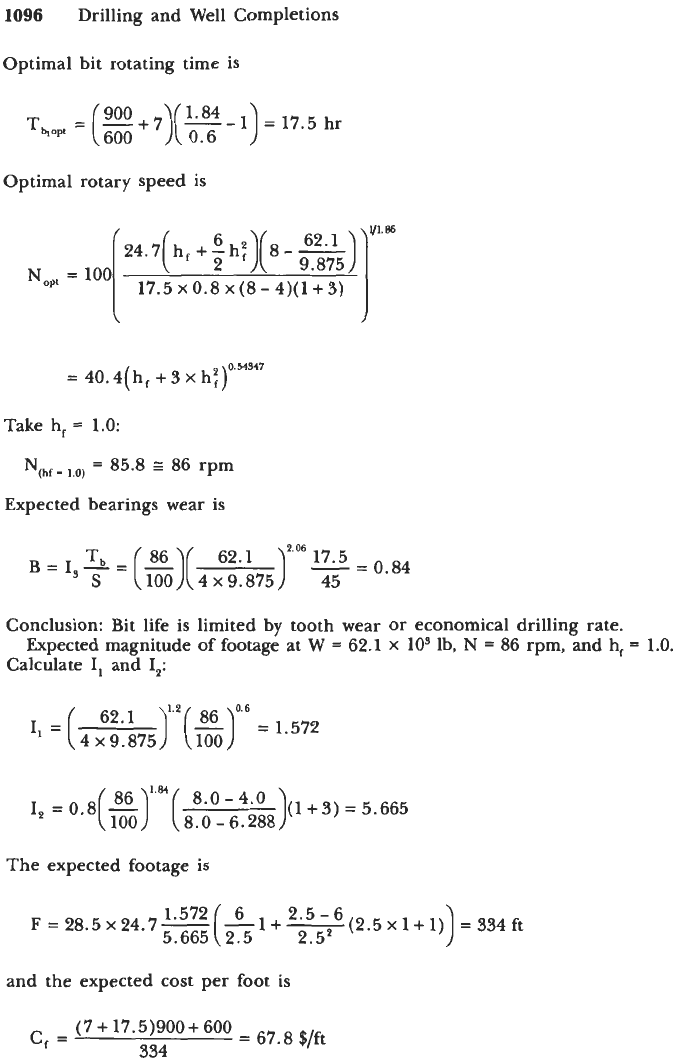
1096
Drilling and Well Completions
Optimal bit rotating time is
T~~~
=(%+7)(z-1)=17.5
hr
Optimal rotary speed is
1/1.86
24.7(
h,
+
$
h:)(
8
-
s)
1
17.5
x
0.8
x
(8
-
4)(1+
3)
N,
=
100
=
40.4(
h,
+
3
x
h:)0'M347
Take h,
=
1.0:
N,,
l.o)
=
85.8
z
86
rpm
Expected bearings wear is
B=I,%=
(
-
86)( 62.1
)*'06
-=
1:;
o.84
S
100
4~9.875
Conclusion: Bit life
is
limited by tooth wear
or
economical drilling rate.
Calculate
I,
and
I,:
Expected magnitude of footage at
W
=
62.1
x
lo3
lb,
N
=
86
rpm,
and
h,
=
1.0.
0.6
I,
=
(
62'1
r2($)
=
1.572
4
x
9.875
I,
=
o#8($ym(
8.0
-
6.288
The expected footage is
2 5-6
1
+
+(2.5
x
1
+
I)
and the expected cost
per
foot is
(7
+
17.5)900
+
600
-
67.
s,ft
c,
=
-
334

Selection of Drilling Practices
1097
Further calculations can be performed for h,
=
0.9;
however, in the case
considered, the expected cost per foot is higher. Consequently, the bit life is
limited by tooth wear,
and
the computations are completed.
Selection
of
Optimal Nozzle Size and
Mud
Flowrate
Optimal hydraulics is the proper balance
of
hydraulic parameters (f lowrate
and equivalent nozzle size) that satisfy chosen criteria of optimization. Hydraulic
quantities used to characterize jet bit performance include hydraulic horsepower,
jet impact force, jet velocity, Reynolds number at the nozzle, generalized drilling
rate or cost per foot drilled. While designing the hydraulic program the
limitations due to
cuttings
transport in the annulus and pump performance
characteristics must be included.
An estimate of the minimum required mud flow velocity in annular space to
assure
v,
where
adequate cuttings transport-can be estimated from-
Van
=
annular velocity in ft/s
D,
=
bore-hole diameter in in.
7,
=
mud weight in lb/gal
(4-28
1)
The mud pump performance characteristic can be thought of as being composed
of two operating ranges.
Range
1
is
p,
=
p,
+
pd
=
const
(4-282)
Range
2
is
HPp
=
HP,
+
HP,
=
const
(4-283)
where p,
=
pump pressure in psi
pb
=
bit pressure drop in psi
pd
=
pressure drop through remaining circulating system in psi
HP,
=
pump hydraulic horsepower
HP,
=
hydraulic horsepower developed at the bit
HPd
=
hydraulic horsepower dissipated through the remaining circulating
system
Range
1
of the mud pump performance characteristic is defined by the
performance of the smallest liner, and range
2
is defined by the remaining
liners. The pressure
loss
in a circulating system, except for bit (pd), can be
estimated from numerous theoretical formulas or from a f lowrate test. Data
obtained from a flowrate test can be approximated using a curve-fitting tech-
nique by the following function:
(4-284)
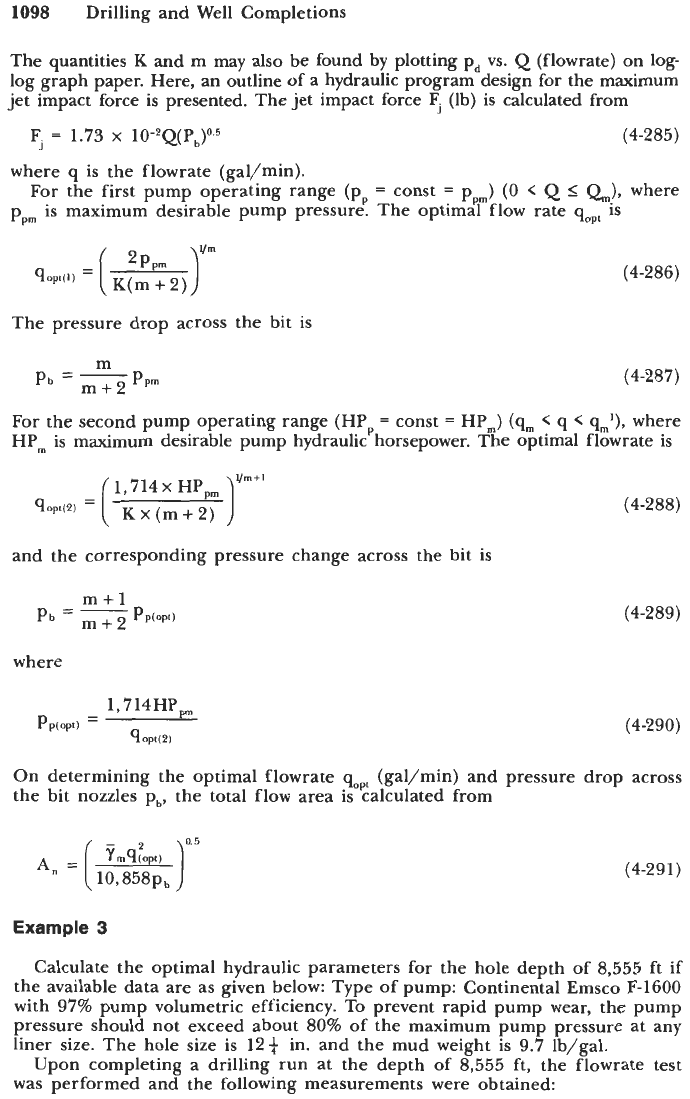
1098
Drilling and Well Completions
The quantities
K
and m may also be found by plotting pd vs.
Q
(flowrate) on log-
log graph paper. Here, an outline of a hydraulic program design for the maximum
jet impact force is presented. The jet impact force Fj (lb) is calculated from
F,
=
1.73
x
~o-*Q(P,)o.~
(4-285)
where q is the flowrate (gal/min).
For the first pump operating range (p,
=
const
=
p,,)
(0
<
Q
5
Q),
where
is maximum desirable pump pressure. The optimal flow rate qopt is
PP,
The pressure drop across the bit is
(4-286)
(4-287)
For the second pump operating range (HPp
=
const
=
HP,) (4,
<
q
<
9,'))
where
HPm is maximum desirable pump hydraulic horsepower. The optimal flowrate is
)""'
1,714 x HP,,
K
x(m
+
2)
qopr(2)
=
and the corresponding pressure change across the bit is
where
1, 714HP,,
qoPr(2)
PP(OP1)
=
(4-288)
(4-289)
(4-290)
On determining the optimal flowrate qopt (gal/min) and pressure drop across
the bit nozzles pb, the total flow area is calculated from
(4-29 1)
Example
3
Calculate the optimal hydraulic parameters for the hole depth of 8,555 ft if
the available data are as given below: Type of pump: Continental Emsco F-1600
with 97% pump volumetric efficiency. To prevent rapid pump wear, the pump
pressure should not exceed about
80%
of the maximum pump pressure at any
liner size. The hole size is 12+ in. and the mud weight
is
9.7 lb/gal.
Upon completing a drilling run at the depth of 8,555 ft, the flowrate test
was performed and the following measurements were obtained:
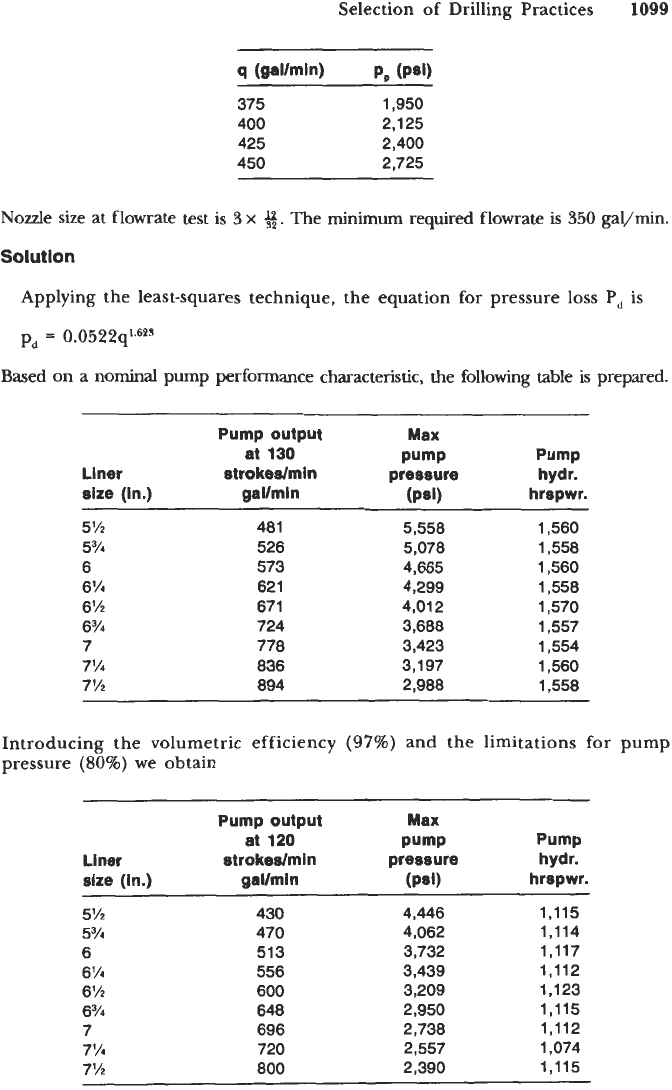
Selection of
Drilling Practices
1099
9
(WmW P, (Psi)
375 1,950
400 2,125
425 2,400
450 2,725
Nozzle size at flowrate test is
3
x
g.
The minimum required flowrate
is
350
gal/min.
Solution
Applying the least-squares technique, the equation for pressure loss
P,
is
pd
=
0.0522q’~643
Based
on
a
nominal
pump perfonnance characteristic,
the
following table
is
prepared.
Pump output
Max
at
130
Pump Pump
Liner strokedmin pressure hydr.
size (in.) gallmln (Psi) hrspwr.
5% 481
5,558 1,560
5Y4 526 5,078 1.558
6 573
4,665 1,560
6% 621 4,299 1,558
6% 67 1
4,012 1,570
6Y4 724
3,688 1,557
7 778
3,423 1,554
7% 836 3,197 1,560
7% 894
2,988 1,558
Introducing the volumetric efficiency
(97%)
and the limitations for pump
pressure
(80%)
we obtain
~~~
Pump output
Max
at
120
Pump Pump
Liner stro kedm
i
n pressure hydr.
slze (in.) gallm
I
n (Psi) hrspwr.
5’/z
430 4,446 1,115
5Y4 470 4,062 1,114
6 513 3,732 1,117
6
‘/4
556 3,439 1,112
6%
600 3,209 1,123
6Y4 648 2.950 1,115
7 696 2,738 1,112
7% 720 2,557 1,074
7% 800 2,390 1,115

1100
Drilling and Well Completions
For
further calculations the maximum pump pressure of
4,446
psi and maximum
hydraulic horsepower of
1,110
hp is accepted. Also, q,
=
430
gal/min and q',
=
800
gal/min. Since q,
>
q,, we calculate qopr(') from Equation
4-288:
1/1.62S+I
=
466
gal/min
1,716
x
1,100
(1.623
+
2)0. 0522
then, applying Equation
4-290,
The liner size is
5
+
in. The number of strokes per minute is
119.
Pressure drop
across the bit from Equation
4-289
is
2'623 4,045
=
2,928
psi
Pb
=3.623
Calculate the total nozzle area from Equation
4-291:
=
0.2574
in.2
=
[
9.7 x 466'
)0'5
10,858~ 2,928
The nozzles sizes are
4,
3
and
$
in. For the selected set of nozzles, the total
flow area is
0.2554
in.', which will result in slightly higher pump pressure than
4,446
psi; however, this seems to be acceptable.
WELL PRESSURE
CONTROL
Introduction
Basically all formations penetrated during drilling are porous and permeable to
some degree. Fluids contained in pore spaces are under pressure that is overbalanced
by the drilling fluid pressure in the well bore. The bore-hole pressure is equal to
the hydrostatic pressure plus the friction pressure loss in the annulus. If for some
reason the borehole pressure falls below the formation fluid pressure, the formation
fluids can enter the well. Such an event is known as a
kick.
This name is associated
with a rather sudden flowrate increase observed at the surface.
A formation fluid influx (a kick) may result from one of the following reasons:
abnormally high formation pressure is encountered
lost circulation
mud weight too low
swabbing in during tripping operations
not filling up the hole while pulling out the drillstring
recirculating gas or oil cut mud.
If a kick is not controlled properly, a blowout will occur.
A
blowout may
develop for one
or
more of the following causes:
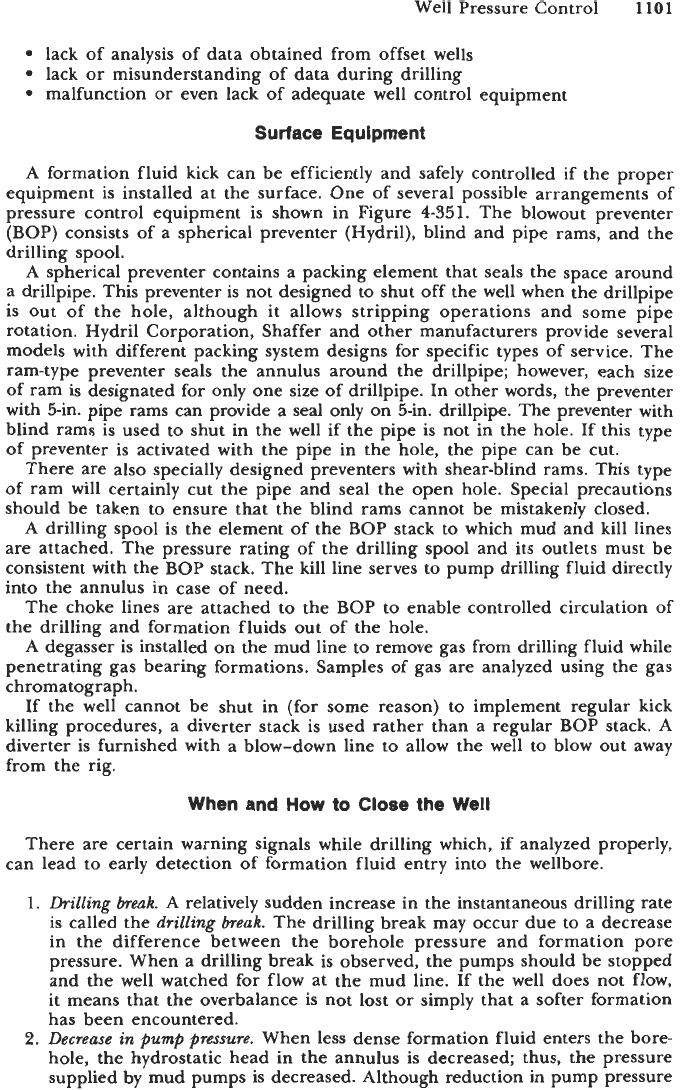
Well Pressure Control
1101
lack of analysis of data obtained from offset wells
lack
or
misunderstanding of data during drilling
malfunction
or
even lack of adequate well control equipment
Surface Equipment
A
formation fluid kick can be efficiently and safely controlled
if
the proper
equipment is installed at the surface. One of several possible arrangements of
pressure control equipment is shown in Figure 4-351. The blowout preventer
(BOP) consists of a spherical preventer (Hydril), blind and pipe rams, and the
drilling spool.
A
spherical preventer contains a packing element that seals the space around
a drillpipe. This preventer is not designed to shut off the well when the drillpipe
is out of the hole, although it allows stripping operations and some pipe
rotation. Hydril Corporation, Shaffer and other manufacturers provide several
models with different packing system designs for specific types of service. The
ram-type preventer seals the annulus around the drillpipe; however, each size
of ram is designated for only one size of drillpipe. In other words, the preventer
with
Sin. pipe rams
can
provide a seal
only
on 5-in. drillpipe. The preventer with
blind rams is used to shut in the well if the pipe is not in the hole. If this type
of preventer is activated with the pipe in the hole, the pipe can be cut.
There are also specially designed preventers with shear-blind rams. This type
of ram will certainly cut the pipe and seal the open hole. Special precautions
should be taken to ensure that the blind rams cannot be mistakenly closed.
A
drilling spool is the element
of
the BOP stack to which mud and kill lines
are attached. The pressure rating of the drilling spool and its outlets must be
consistent with the BOP stack. The kill line serves to pump drilling fluid directly
into the annulus in case of need.
The choke lines are attached to the BOP to enable controlled circulation of
the drilling
and
formation fluids out of the hole.
A
degasser is installed on the mud line to remove gas from drilling fluid while
penetrating gas bearing formations. Samples
of
gas are analyzed using the gas
chromatograph.
If the well cannot be shut in (for some reason) to implement regular kick
killing procedures, a diverter stack is used rather than a regular BOP stack.
A
diverter is furnished with a blow-down line to allow the well to blow out away
from the rig.
When and How
to
Close the Well
There are certain warning signals while drilling which, if analyzed properly,
can lead to early detection of formation fluid entry into the wellbore.
1.
Drilling
bwak.
A
relatively sudden increase in the instantaneous drilling rate
is
called the
drilling
break.
The drilling break may occur due to a decrease
in the difference between the borehole pressure and formation
pore
pressure. When a drilling break is observed, the pumps should be stopped
and the well watched for flow at the mud line. If the well does not flow,
it means that the overbalance is not lost or simply that
a
softer formation
has been encountered.
2.
Decrease
in
pump
pressure.
When less dense formation fluid enters the bore-
hole, the hydrostatic head in the annulus is decreased; thus, the pressure
supplied by mud pumps is decreased. Although reduction in pump pressure
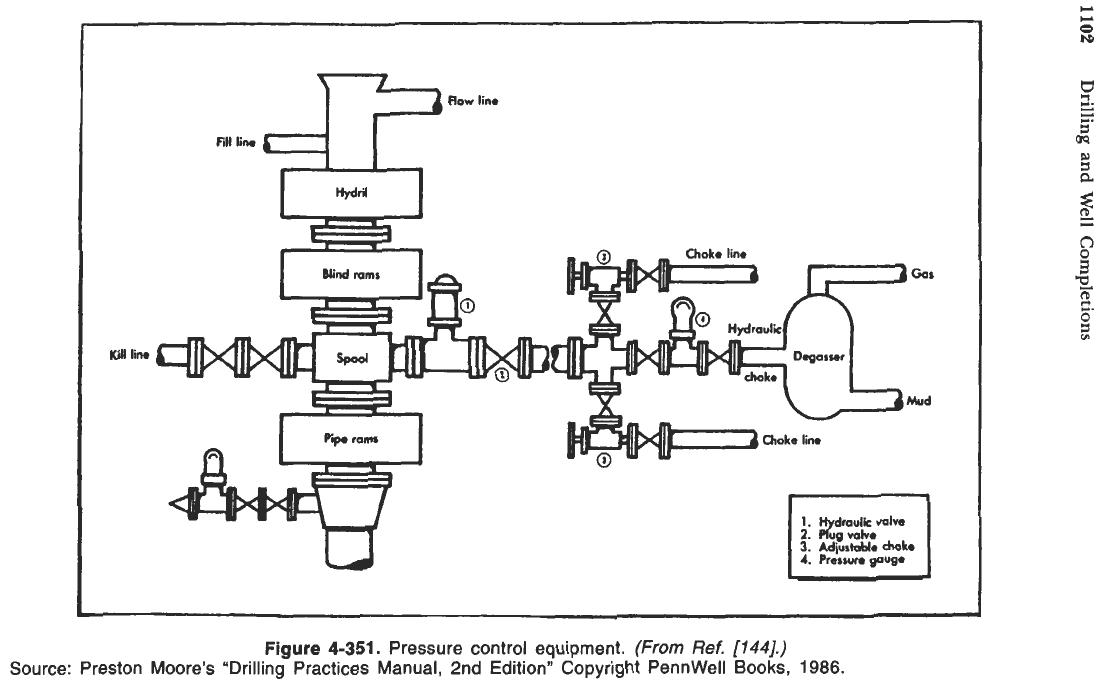
flow
line
l-3
Blind
rams
Kill
line
1
H
drauli
valve
4.
Prerrun
gauge
3.
2:
dgwk
Adpstablechoko
Figure
4-351.
Pressure control equipment.
(From
Ref.
[144].)
Source: Preston Moore’s “Drilling Practices Manual, 2nd Edition” Copyright PennWell
Books,
1986.
U
0
N
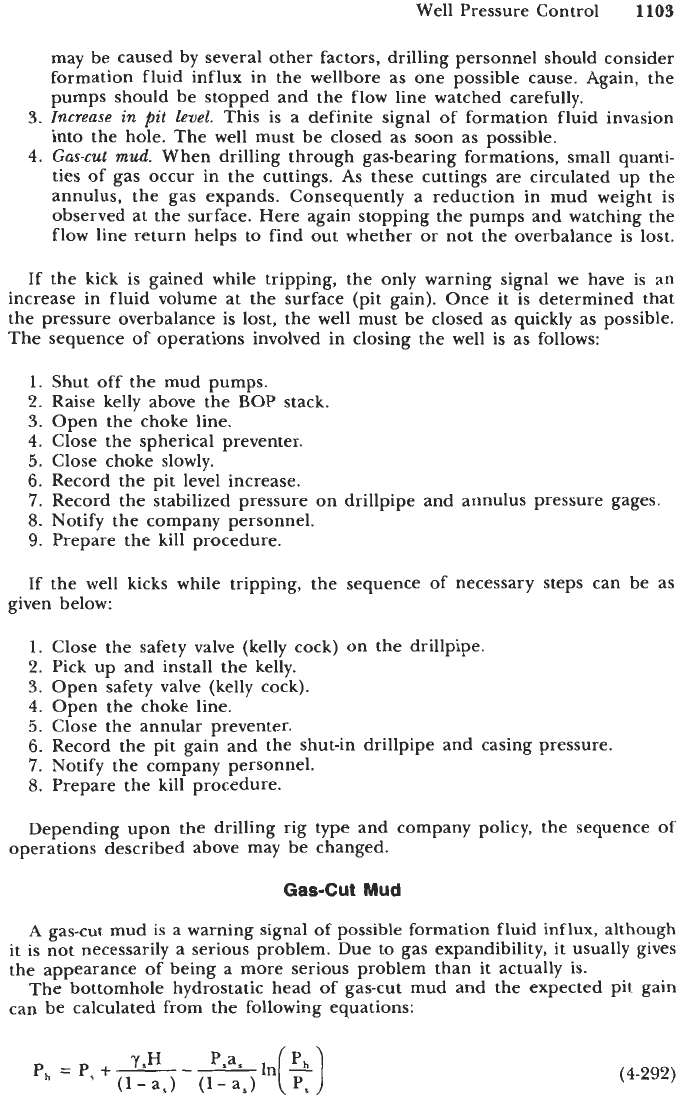
Well Pressure Control
1103
may be caused by several other factors, drilling personnel should consider
formation fluid influx in the wellbore as one possible cause. Again, the
pumps should be stopped and the flow line watched carefully.
3.
Increase
in
pit
level.
This is a definite signal of formation fluid invasion
into the hole. The well must
be
closed as soon as possible.
4.
Gas-cut
mud.
When drilling through gas-bearing formations, small quanti-
ties of gas occur in the cuttings.
As
these cuttings are circulated up the
annulus, the gas expands. Consequently a reduction in mud weight is
observed at the surface. Here again stopping the pumps and watching the
flow line return helps to find out whether or not the overbalance is lost.
If
the kick is gained while tripping, the only warning signal we have is an
increase in fluid volume at the surface (pit gain). Once it is determined that
the pressure overbalance is lost, the well must be closed as quickly as possible.
The sequence of operations involved in closing the well
is
as follows:
1.
Shut off the mud pumps.
2.
Raise kelly above the
BOP
stack.
3.
Open the choke line.
4.
Close the spherical preventer.
5.
Close choke slowly.
6.
Record the pit level increase.
7.
Record the stabilized pressure on drillpipe and annulus pressure gages.
8.
Notify the company personnel.
9.
Prepare the kill procedure.
If the well kicks while tripping, the sequence of necessary steps can be
as
given below:
1.
Close the safety valve (kelly cock) on the drillpipe.
2.
Pick up and install the kelly.
3.
Open safety valve (kelly cock).
4.
Open the choke line.
5.
Close the annular preventer.
6.
Record the pit gain and the shut-in drillpipe and casing pressure.
7.
Notify the company personnel.
8.
Prepare the kill procedure.
Depending upon the drilling rig type and company policy, the sequence
of
operations described above may be changed.
Gas-Cut
Mud
A
gas-cut mud
is
a warning signal of possible formation fluid influx, although
it is not necessarily a serious problem. Due to gas expandibility, it usually gives
the appearance
of
being a more serious problem than it actually is.
The bottomhole hydrostatic head of gas-cut mud and the expected pit gain
can be calculated from the following equations:
(4-292)
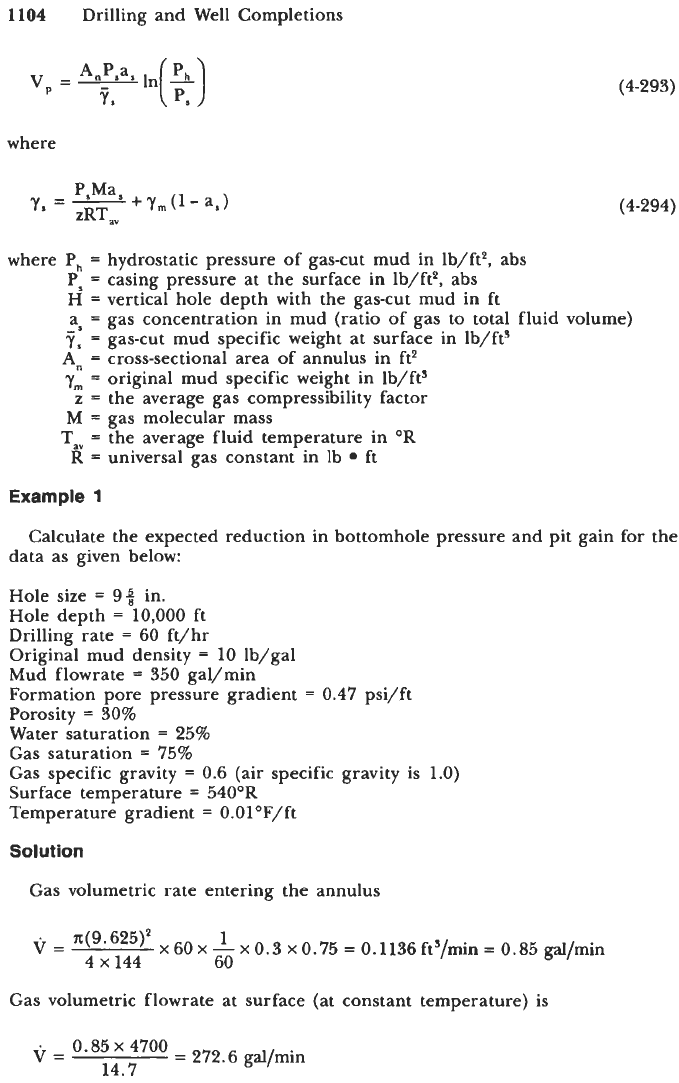
1104
Drilling and Well Completions
where
(4-293)
(4-294)
where
P,
=
hydrostatic pressure of gas-cut mud in lb/ft2, abs
Ps
=
casing pressure at the surface in lb/ft*, abs
H
=
vertical hole depth with the gas-cut mud in ft
a,
=
gas concentration in mud (ratio of gas to total fluid volume)
Ts
=
gas-cut mud specific weight at surface in lb/ft3
An
=
cross-sectional area of annulus in ft2
y,
=
original mud specific weight in lb/ft3
z
=
the average gas compressibility factor
M
=
gas molecular mass
Tav
=
the average fluid temperature in
OR
R
=
universal gas constant in lb ft
Example
1
Calculate the expected reduction in bottomhole pressure and pit gain for the
data as given below:
Hole size
=
99
in.
Hole depth
=
10,000
ft
Drilling rate
=
60 ft/hr
Original mud density
=
10 lb/gal
Mud flowrate
5
350
gal/min
Formation pore pressure gradient
=
0.47
psi/ft
Porosity
=
30%
Water saturation
=
25%
Gas saturation
=
75%
Gas specific gravity
=
0.6
(air specific gravity is 1.0)
Surface temperature
=
540'R
Temperature gradient
=
O.0loF/ft
Solution
Gas volumetric rate entering the annulus
1
4
x
144
60
v=
n(9'625)*
x
60
x
-
x
0.3
x
0.75
=
0.1136
ft3/min
=
0.85
gal/min
Gas volumetric f lowrate at surface (at constant temperature) is
